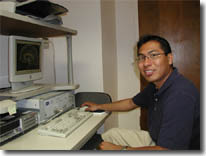Space Grant group helps build scientific knowledge

An image from a brain scan may look like a gray mass to the untrained eye. But Joshua Lucio is able to detect the slightest change from image to image.
Lucio isn't a doctor, a professor or even a graduate student. He's a University of Arizona microbiology senior who's spent seven months looking at MRI scans taken before and after patients with brain diseases underwent radiation treatments.
Lucio's work is done through the Arizona Space Grant Consortium, which involves dozens of UA students and is led by Michael Drake, head of the UA's Lunar and Planetary Laboratory.
The statewide program brings together the UA, Arizona State University, Northern Arizona University, Embry-Riddle Aeronautical University and 23 affiliate members, said Barron Orr, associate director of UA's program. The UA is the lead institution for the state consortium, which receives nearly $600,000 from NASA each year to fund educational programs geared to provide people the opportunity to learn about science and engineering, Orr said.
Participating groups make significant contributions to support the consortium's programs. With the projected contributions for 2007, the state program's budget is more than $1.2 million, Susan Brew, manager for the state and UA programs, said in an e-mail.
"Statewide, the flagship program is a large undergraduate research-internship program that supports 141 undergrads in 2006," she wrote. "In addition, 14 graduate students at UA and ASU receive fellowship support to engage in research programs, and at UA, to design and implement an educational-outreach program related to their graduate work."
There are more than 60 UA undergraduate interns working on a variety of topics this year, including microwave spectroscopy, documenting vegetation change using photography and working in public affairs for the Phoenix Mars Mission lander project. The lander will launch in August and is scheduled to reach Mars in May 2008. There's even a spot for a science-writing intern at the Arizona Daily Star. Six graduate students spent the year developing and implementing scientific outreach projects.
The Arizona Space Grant Consortium was created in 1989, a year after Congress passed the National Space Grant Act. The national program now includes consortia in all 50 states, plus Puerto Rico and Washington, D.C. Arizona has been ranked in the top category each time the program has been reviewed by the national program.
In addition to supporting science programs, Orr said, the program tries to expose historically underrepresented people to science, technology, engineering and math.
"The transfer of knowledge between the scientific community and the public is essential," he said.
Lucio's work may affect the public one day. He said the project he's working on is a new technique that could have wider ramifications.
Lucio is one of more than 830 undergraduate students who have gone through the intern program in its 18 years. Students apply based on their interests, and those who are selected are matched with a mentor to work on a specific project.
Lucio worked mainly with cells in previous internships but said this experience has been exciting because the project is very new.
"We as interns are put in the driver's seat," he said. "You might not know what you're getting into, but in the end you're doing something."

